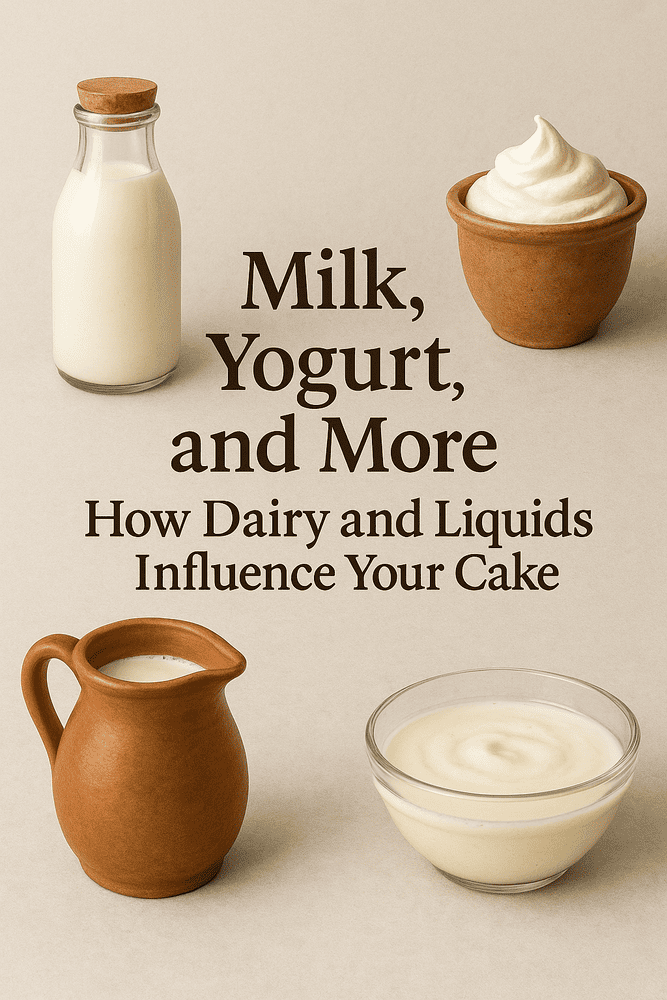When we think about the ingredients in a cake, dairy often gets overlooked. Yet milk, yogurt, cream, and other liquids play essential roles in determining a cake’s texture, richness, flavor, and structure. Whether you’re aiming for a light sponge or a dense pound cake, the type and amount of liquid you use can make all the difference.
Let’s begin with milk, the most common liquid in cake recipes. Milk adds moisture, helps dissolve sugar and salt, and contributes to the cake’s overall texture. It also enhances flavor and improves the browning of the crust. Whole milk is usually preferred in baking because its fat content adds richness and tenderness. However, low-fat or non-dairy alternatives can be used with adjustments.
Milk contains lactose (milk sugar), which caramelizes in the oven and gives the cake a golden color. It also contributes to a mild sweetness and helps with leavening when combined with baking powder or soda. For example, in a classic vanilla cake, milk helps distribute ingredients evenly and creates a fine crumb.
Next is yogurt, a cultured dairy product that brings acidity and moisture to the batter. The acidity in yogurt reacts with baking soda to create carbon dioxide, giving your cake lift and a fluffy texture. Yogurt is especially useful in recipes where tenderness is key. It’s commonly used in coffee cakes, spice cakes, and even chocolate cakes.
Greek yogurt, which is thicker and more concentrated, provides more fat and protein. It creates a denser texture and can be used in smaller amounts than regular yogurt. Yogurt also adds a subtle tanginess, which balances overly sweet cakes and enhances the overall depth of flavor.
Buttermilk is another powerhouse in baking. Like yogurt, it’s acidic and interacts with leavening agents to produce a light texture. Buttermilk is thinner than yogurt but still adds richness and a slight tang. Southern-style cakes and red velvet cakes often rely on buttermilk to achieve their characteristic crumb.
Now let’s explore cream and sour cream. Heavy cream adds fat and luxury to a cake, resulting in a rich, velvety crumb. Sour cream, similar to yogurt, contributes moisture and acidity. It’s perfect for dense, moist cakes like coffee cake or pound cake. Cakes made with sour cream tend to stay fresh longer and have a soft, tender bite.
Some recipes even use evaporated milk or condensed milk, especially in tres leches cake or milk-based frostings. These provide concentrated sweetness and creaminess and should be used in recipes specifically designed for them.
Besides dairy, there are also other liquids to consider, such as:
- Water: Often used in combination with other liquids, it adds moisture without altering flavor. Useful in vegan recipes or where other ingredients dominate the flavor profile.
- Juices: Lemon juice, orange juice, or apple juice can enhance both moisture and flavor but may require pH adjustments due to their acidity.
- Coffee: Common in chocolate cakes, coffee deepens flavor and pairs well with cocoa.
- Alcohol: A splash of rum, bourbon, or liqueur can add complexity, but be cautious with quantities.
Each liquid interacts differently with other ingredients. For example, acidic liquids (yogurt, buttermilk, sour cream) activate baking soda. Neutral liquids (milk, water) often work better with baking powder. Using the wrong combination can lead to poor rise or off flavors.
Here are key things to remember when working with liquids:
- Measure accurately: Too much liquid can lead to a dense, underbaked cake. Too little, and your cake may turn dry.
- Use room temperature liquids: Cold liquids can harden fats and cause batter to curdle. Let them sit out for 20–30 minutes before mixing.
- Adjust fat content accordingly: If you replace milk with yogurt, consider reducing other fats slightly to avoid a greasy texture.
- Don’t overmix: Liquid-heavy batters can develop too much gluten if mixed too long, leading to a chewy cake.
Let’s look at some popular cake types and the ideal liquids for each:
- Vanilla or white cakes: Whole milk or buttermilk for lightness and flavor
- Chocolate cakes: Coffee or buttermilk for depth and moisture
- Pound cakes: Sour cream or yogurt for richness and density
- Spice cakes: Yogurt or applesauce for balanced moisture
- Fruit cakes: Orange juice, rum, or milk depending on the base
If you’re baking dairy-free, many plant-based milks (like almond, soy, or oat) can be substituted 1:1 for milk. Just choose unsweetened and unflavored versions, and be aware they have less fat and protein than dairy, which can slightly alter texture and browning.
Liquid ratios also affect the batter consistency. Thicker batters hold their shape better in the oven, while thinner batters may spread more and take longer to bake. Don’t panic if your batter looks different depending on the liquid—it’s normal.
Recap of how liquids influence your cake:
- Moisture: Hydrates flour and helps dissolve other ingredients
- Tenderness: Fat from dairy adds softness
- Flavor: Dairy and alternative liquids add subtle notes
- Leavening: Acidity activates baking soda
- Shelf life: Proper moisture extends freshness
To experiment, try baking the same recipe using different liquids and compare the results. You’ll quickly notice how just one change can transform a cake’s texture and taste.
If you’ve followed along with our series on flour, sugar, eggs, and fats, this article on liquids completes the puzzle. In our next article (#10), we’ll discuss how baking temperatures and oven types influence cake success—and how to troubleshoot baking problems like dry edges or sunken centers.
